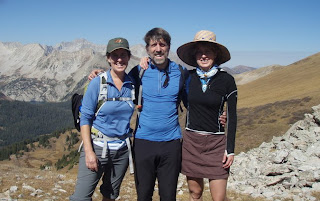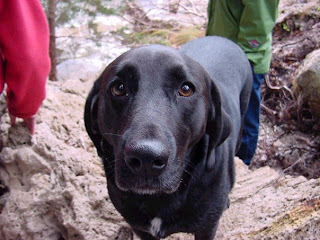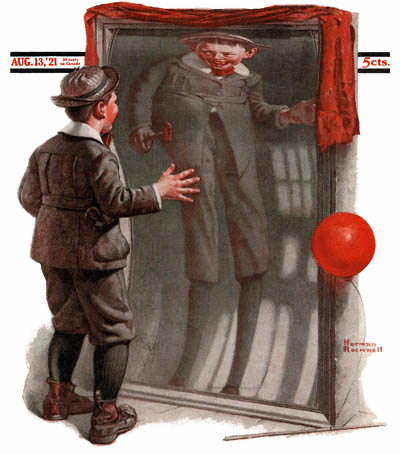I’ve just introduced myself to the pleasures of Aldo Leopold’s A Sand County Almanac, and Sketches Here and There. Called the father of wildlife conservation in the United States, Leopold heard in the revving of the great American economic and technological engines the death knell of what he called “the biotic community,” in which humanity is merely a fellow-passenger, not the driver. A Sand County Almanac was published posthumously in 1949; more than sixty years later, Leopold’s ability to see where those engines would take us seems eerily prophetic.
Aside from what he says, I love his tone—warm and humble, courteous and scholarly. But what he says is compelling and important. In one essay, “Thinking Like a Mountain,” he recounts an experience he had as a young man working for the Forest Service in Arizona, at a time when land managers “had never heard of passing up a chance to kill a wolf.” One day, from a “high rimrock,” he and his colleagues spotted a pack of wolves, including some pups, and opened fire. Leopold, having shot a female, climbed down and “reached the old wolf in time to watch a fierce green fire dying in her eyes. I realized then, and have known ever since, that there was something new to me in those eyes—something known only to her and to the mountain. I was young then, and full of trigger-itch; I thought that because fewer wolves meant more deer, that no wolves would mean hunters’ paradise. But after seeing the green fire die, I sensed that neither the wolf nor the mountain agreed with such a view.”
Over the years, as he watched the destruction of the wolf population and the subsequent explosion of the deer population and disappearance of the mountain flora, Leopold came to understand the wolves’ vital place in the biotic community. He became a passionate, but never strident, defender of predators and other despised or voiceless members of his tribe, like soil, water, flowers, and mountains.
I’m thinking about the mind of the mountains because last week my sister Isa, my brother John, and I walked into what we consider their heart. We climbed up to Buckskin Pass, our mother’s favorite hike, on the first anniversary of her death. We agreed that one of her greatest gifts to us was a deep, abiding love for wild places, especially those in Colorado, a love she shared with everyone she could. I don’t know if she ever read A Sand County Almanac, but I know that she, too, thought about her response to the inner life of mountains and encouraged us to do likewise.
At the end of “Thinking Like a Mountain,” Leopold writes this: “We all strive for safety, prosperity, comfort, long life, and dullness…. A measure of this is all well enough, and perhaps is a requisite to objective thinking, but too much safety seems to yield only danger in the long run. Perhaps this is behind Thoreau’s dictum: In wildness is the salvation of the world. Perhaps this is the hidden meaning in the howl of the wolf, long known among mountains, but seldom perceived among men.”
I was particularly taken with his misquotation of Thoreau; in a previous post I wrestled with my own misquotation of the same line. What Thoreau actually wrote was this: “In wildness is the preservation of the world.” But I love Leopold’s rendering, since the substitution of “salvation” for “preservation” gives the minds of wolves and mountains a distinctly theological dimension. (Coincidentally, I’ve also just discovered Thomas Berry, an ecology-minded priest and writer who proclaimed himself a “geologian.”)
How might the wild minds of the mountains save us? I’m not sure there’s a single answer to that question, especially since the mountains are just as capable of destroying as saving. I remember times during our childhood forced marches when we had to sprint down from above tree line to avoid summer storms that seemed to come out of nowhere, bristling lightning. Even as their come-hither beauty draws me to these high places, their monastic austerity keeps me in my place. My brother John, an alpinist by vocation and avocation, has spent more time dangling in very thin air than most normal people, and he confirms the almost erotic call and implacable heart of the mountains—or at least I feel sure he would if I asked him.
How might the wild minds of the mountains save us? Here’s one answer: in The Solace of Fierce Places: Exploring Desert and Mountain Spirituality, Belden C. Lane recounts the parable of an Englishman visiting Tibet some years ago:
Only as the grandeur of the land drew him beyond himself did he begin to discover what he sought. Walking one day toward a remote monastery at Rde-Zong, he was distracted from his quest for spiritual attainment by the play of the sun on stones along the path. “I have no choice,” he protested, “but to be alive to this landscape and light.” Because of this delay, he never arrived at the monastery….
Most compelling to his imagination was the fact that the awesome beauty of this fierce land was in no way conditioned by his own frail presence. It was not there for him…. Hence he declared, “The things that ignore us save us in the end. Their presence awakens silence in us; they restore our courage with the purity of their detachment.” Becoming present to a reality entirely separate from his own world of turmoil strangely set him free.
As John, Isa, and I descended from the emphatic heights, talking about a strangely controversial effort to designate 350,000 nearby acres of national park as a wilderness preserve, John stopped, turning around to look at Isa and me with his mouth wide open, pantomiming astonishment. Wondering what could possibly astonish someone as unflappable as John, I looked down the rocky trail.
A young man with no legs was walking toward us. Yep, walking, on his leather-gloved hands, up a trail that sucked the breath out of people with legs. His concentration was so intense that he was unable to acknowledge our presence. I recognized him as the subject of a story I had read online a few months before. Kevin Michael Connolly, born without legs, is, at age twenty-four, a champion skier, globe-trotting photographer, and charming smart-aleck, if his website is any indication. He’s also the author of a memoir entitled Double Take.
I’ve never been quite as awe-struck by another person as I was in that moment. Once again, I felt very small, amazed by the community—this time the human community—of which I am a part. So many things, people, and circumstances by which I might be saved.
The things that ignore us save us in the end. They allow us to step out of the endless hall of mirrors we usually inhabit and to find ourselves in a relationship with something outside our fears, fantasies, and projections. This was one of our mother’s great gifts: she showed us how we could step outside our defended little selves for a while. She taught us where to find courage when we need it: in this place where we knew ourselves to be small and helpless and yet utterly at home, at least for a few ragged breaths.
What we’re reading
Heather: Malcolm Gladwell, Blink: The Power of Thinking Without Thinking
Martin: Ingrid D. Rowland, Giordano Bruno: Philosopher/Heretic










